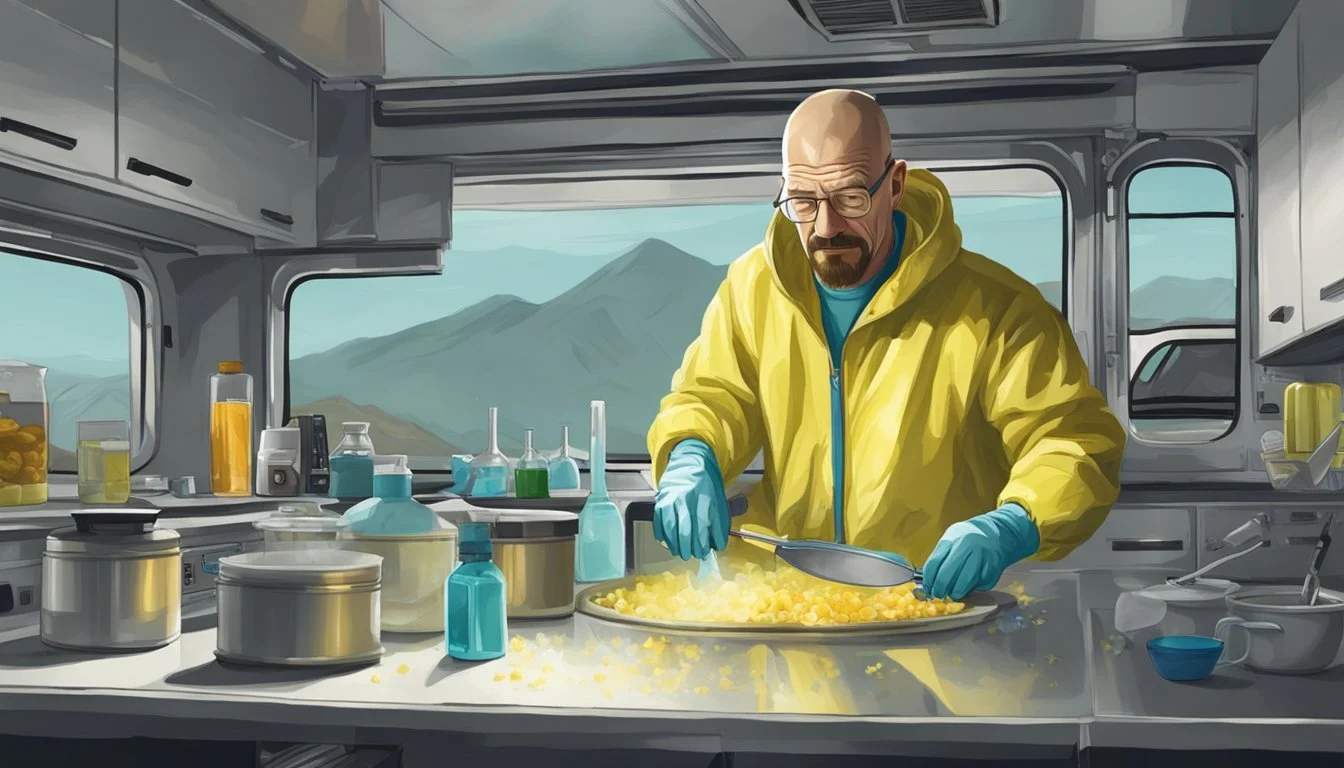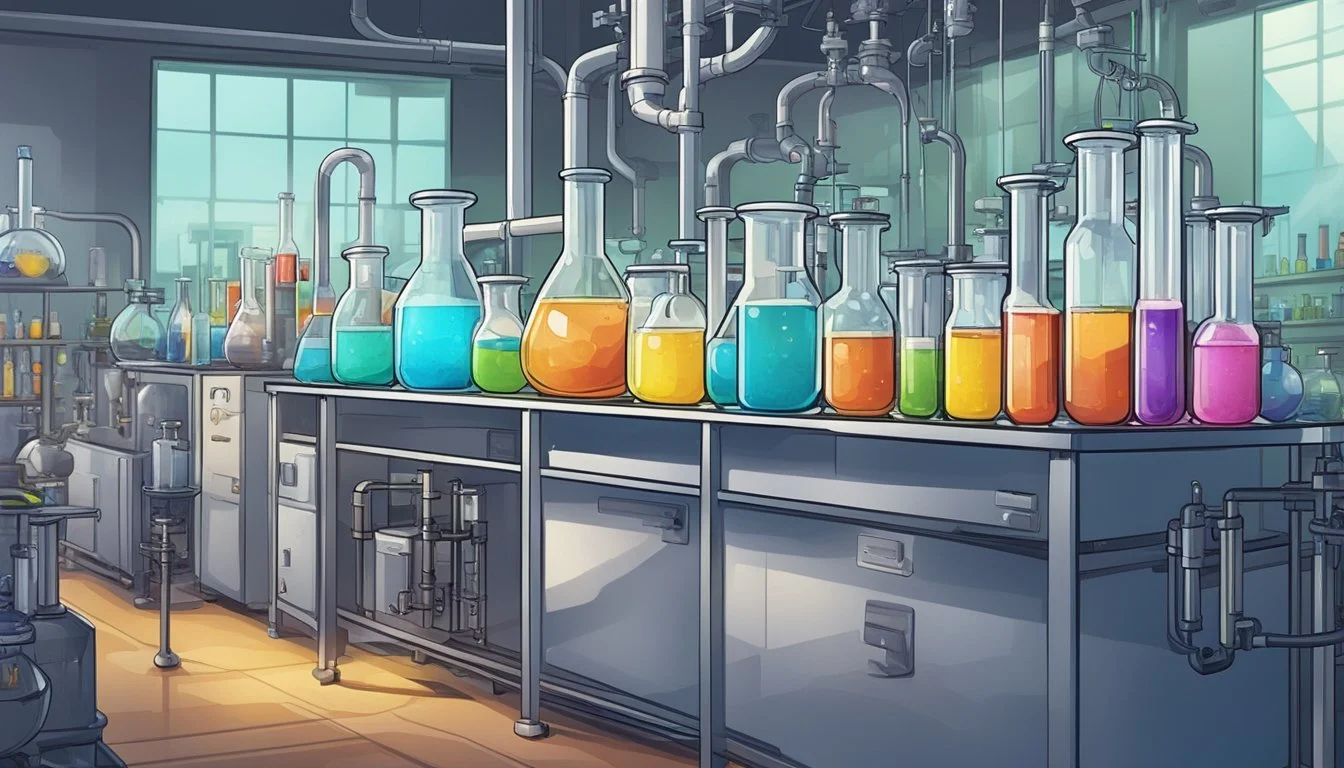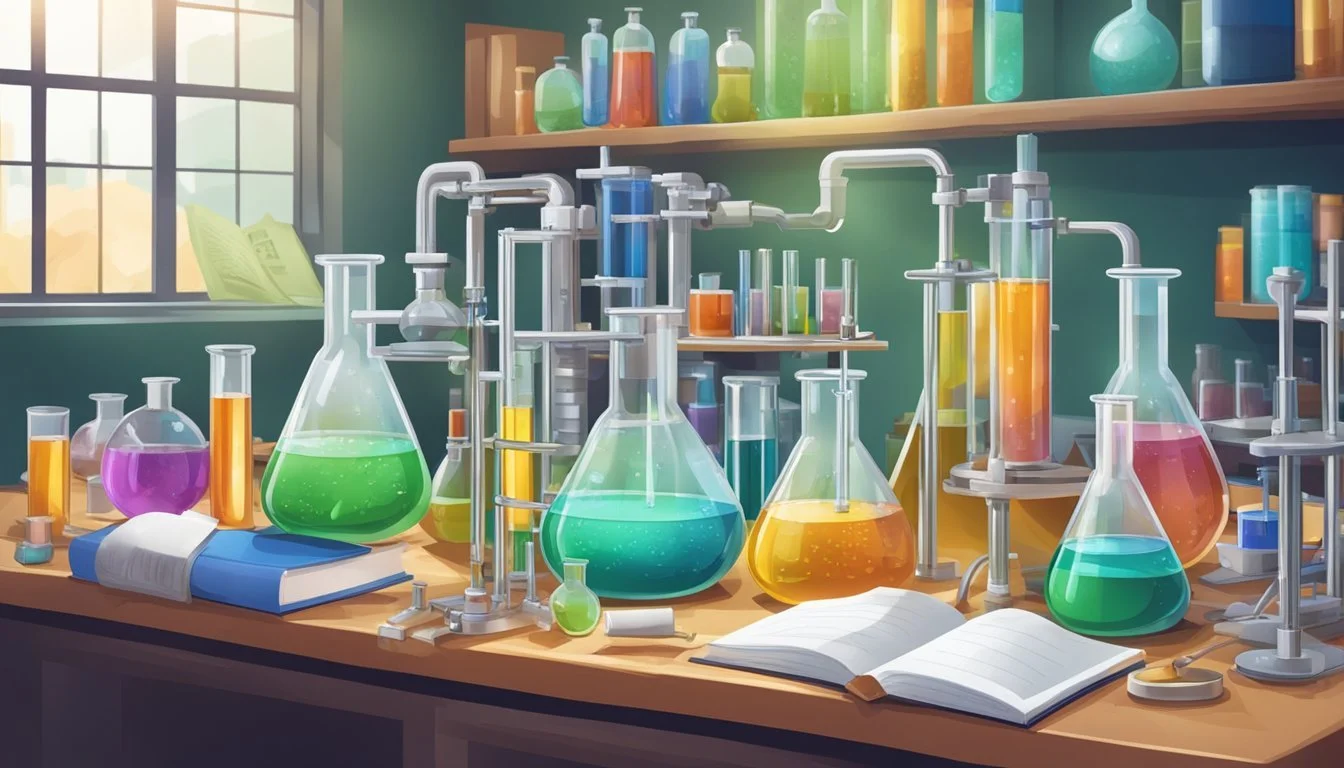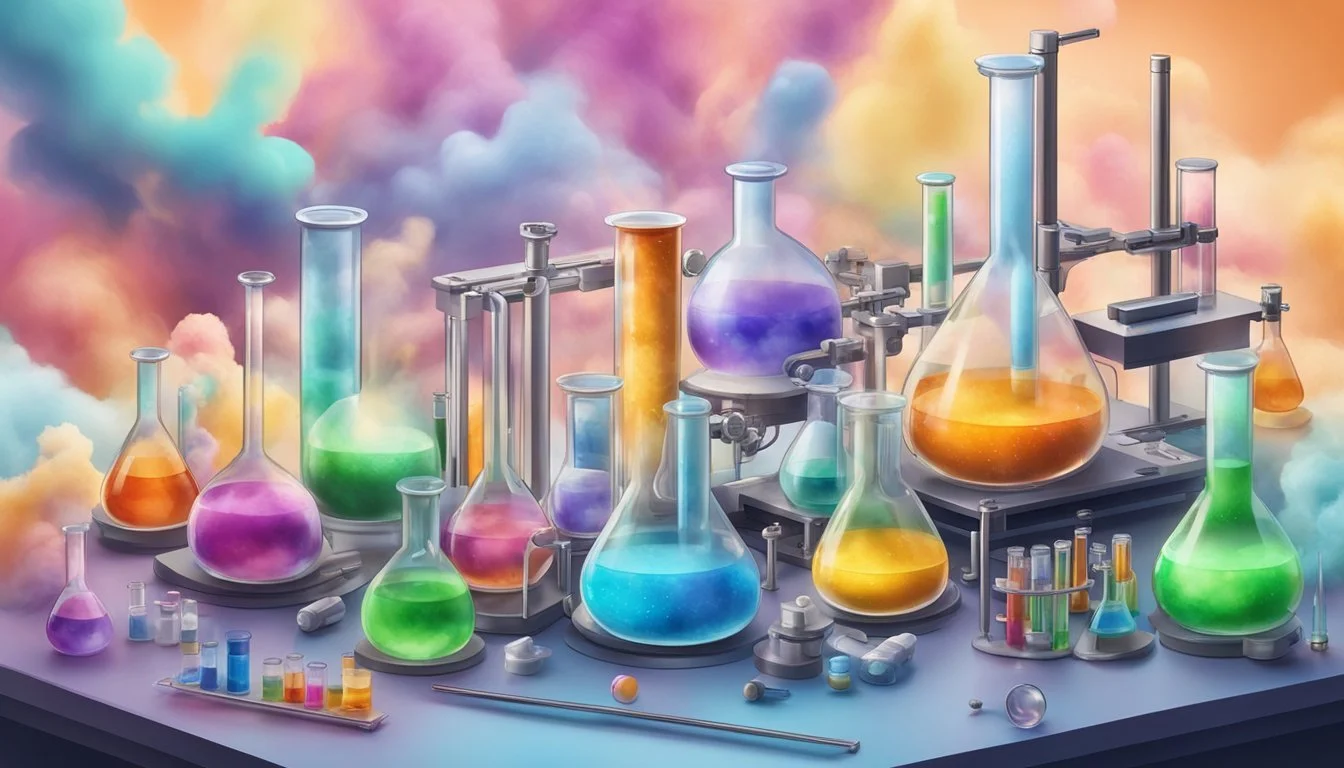Science and Technology: Catalysts for Walt's Transformation in Breaking Bad
How Chemistry Fueled a Criminal Empire
Breaking Bad captivated audiences with its gripping narrative of a high school chemistry teacher's transformation into a methamphetamine kingpin. At the core of this transformation lies Walter White's expertise in science and technology, which he leverages to navigate the dangerous world of drug manufacturing and distribution.
Walter White's background as a talented chemist becomes the catalyst for his metamorphosis into the notorious Heisenberg. His deep understanding of chemical processes and laboratory techniques enables him to produce a superior product, quickly establishing his reputation in the criminal underworld. The show's creators worked closely with scientific experts to ensure the accuracy of chemical terminology and processes, lending authenticity to Walt's journey.
Walt's character arc is intricately tied to his scientific knowledge. As he delves deeper into the criminal world, he applies his chemistry skills in increasingly creative and dangerous ways. From improvising chemical weapons to devising complex production methods, Walt's scientific acumen becomes both his greatest asset and a driving force behind his moral descent. This blend of scientific accuracy and dramatic storytelling sets Breaking Bad apart, making it a unique exploration of how knowledge can be wielded for both creation and destruction.
The Fundamentals of Chemistry in Breaking Bad
Breaking Bad's portrayal of chemistry is grounded in scientific accuracy. The show intertwines chemical principles with plot development, showcasing Walter White's expertise as he transitions from teacher to manufacturer.
Chemical Principles and Plot Development
Breaking Bad weaves chemical concepts into its storylines with precision. The show explores topics like chirality, which plays a crucial role in Walt's methamphetamine production. His "blue meth" is distinguished by its purity and unique color, a result of specific synthesis techniques.
The series also delves into chemical reactions and lab equipment. Viewers learn about distillation, reductive amination, and the use of round-bottom flasks. These details not only educate but also drive the narrative forward.
Walt's knowledge of chemistry enables him to overcome obstacles. He uses fulminated mercury as an explosive and creates thermite from aluminum powder to break into a locked building. This blend of chemistry and storytelling keeps audiences engaged while maintaining scientific integrity.
Walter White's Transition from Teacher to Manufacturer
Walt's background as a chemistry teacher provides the foundation for his illicit activities. His expertise allows him to produce high-quality methamphetamine, setting him apart in the drug trade.
As Walt delves deeper into manufacturing, he applies advanced chemical techniques. He employs the P2P method, using methylamine as a precursor. This shift demonstrates his growing proficiency and willingness to take risks.
Walt's transformation is reflected in his increasingly sophisticated setups. He progresses from a rudimentary RV lab to a state-of-the-art superlab. This evolution showcases his mastery of chemical processes and equipment.
The Role of Chemistry Educators in Consulting
Breaking Bad's creators sought expert advice to ensure scientific accuracy. Donna Nelson, a chemistry professor at the University of Oklahoma, served as the show's primary science advisor.
Nelson provided detailed information on chemical processes, terminology, and lab setups. Her input helped the writers craft realistic dialogue and scenarios. This collaboration enhanced the show's credibility among scientifically-literate viewers.
The involvement of real chemists in the production process set a new standard for scientific authenticity in television. It demonstrated the value of expert consultation in creating compelling, accurate portrayals of science in media.
Depiction of Drug Manufacturing Process
Breaking Bad portrays the illicit production of methamphetamine as a central plot element. The show offers a fictionalized glimpse into clandestine lab operations and chemical processes involved in synthesizing the drug.
The Synthesis of Crystal Meth
Walt employs the pseudoephedrine reduction method to produce methamphetamine initially. This process involves extracting pseudoephedrine from cold medicines and combining it with other chemicals. As the series progresses, Walt transitions to the reductive amination of phenylacetone using methylamine.
This method yields a purer product with a distinctive blue color. The show depicts various chemical reactions, including the use of hydrofluoric acid for disposal of evidence.
Secrecy and Science: Concealed Labs
The series showcases different clandestine lab setups. Walt and Jesse's early operations take place in a recreational vehicle, providing mobility and secrecy. Later, they upgrade to more sophisticated lab environments.
Gus Fring's industrial-scale underground lab represents the pinnacle of concealed manufacturing. The show emphasizes the importance of ventilation, protective gear, and precise measurements in these hidden facilities.
Fiction Versus Reality in Meth Production
While Breaking Bad presents a dramatized version of methamphetamine production, it takes liberties with reality for narrative purposes. The show exaggerates the purity levels achievable and simplifies complex chemical processes.
In reality, meth production is far more dangerous and unpredictable. The series omits many of the severe health risks associated with exposure to toxic chemicals like phosphine gas. It also glosses over the extreme difficulty of achieving high purity levels consistently.
The thermite reaction depicted for breaking into a chemical storage facility is based on real chemistry but dramatized for effect.
Walter White's Character Evolution and Technology
Walter White's transformation in Breaking Bad is inextricably linked to his scientific expertise and the technology he employs. His journey from a mild-mannered chemistry teacher to a ruthless drug kingpin is facilitated by his technical knowledge and innovative use of equipment.
From Desperation to Power
Walter's initial foray into meth production stems from desperation after his cancer diagnosis. He leverages his chemistry background to create a superior product, quickly gaining notoriety as "Heisenberg". This alter ego becomes a symbol of his growing power and confidence.
The mobile meth lab, ingeniously housed in an RV, allows Walt to evade detection in the early stages. This technological innovation marks the beginning of his criminal career and resourcefulness.
As Walt's empire expands, he continually adapts his methods and equipment. His ability to improvise and utilize advanced technology sets him apart from other players in the drug trade.
Scientific Expertise as a Tool for Transformation
Walt's scientific knowledge is the cornerstone of his transformation. He applies his expertise to produce crystal meth of unprecedented purity, establishing a reputation for quality that becomes his trademark.
His background allows him to solve complex problems, from disposal of bodies to large-scale production challenges. This technical prowess becomes a key factor in his rise to power.
Walt's familiarity with chemicals and lab equipment enables him to create deadly poisons and explosives. These scientific "tools" become weapons in his arsenal, used to eliminate rivals and protect his interests.
As the series progresses, Walt's use of technology becomes more sophisticated. He employs state-of-the-art lab equipment and even devises new methods for distribution, showcasing his evolution from amateur to professional criminal.
The Ethical Dilemmas of Scientific Knowledge
Scientific knowledge brings immense power and responsibility. The ability to manipulate chemicals and biological processes creates complex moral choices about their proper use and potential for harm.
Toxic Chemicals and Moral Choice
Walter White's expertise in chemistry enables him to produce high-purity methamphetamine. His knowledge of toxic substances like hydrofluoric acid and ricin also becomes a dangerous tool. The use of hydrofluoric acid to dispose of bodies demonstrates how scientific knowledge can be twisted for criminal ends.
The poisonous plant lily of the valley further exemplifies this ethical quandary. Walt uses his understanding of its toxicity to poison a child, justifying it as a necessary evil. This highlights how scientific knowledge, divorced from moral constraints, can lead to horrific acts.
The Consequences of Scientific Misuse
The thalidomide tragedy of the 1950s-60s serves as a stark reminder of the unforeseen consequences when scientific advancements are not properly vetted. In Breaking Bad, Walt's actions spark a chain of events with far-reaching impacts.
His high-quality meth floods the market, leading to increased addiction and crime. This draws intensified DEA scrutiny, endangering Walt and those around him. The unintended ripple effects demonstrate how scientific breakthroughs, even when not inherently harmful, can be misused with devastating results.
Walt's descent shows how the allure of applying scientific knowledge, even for ostensibly good reasons, can lead down a slippery ethical slope. The power to create or destroy comes with weighty moral burdens.
Real-life Parallels: Impact of Fiction on Public Perception
Fiction can profoundly shape public understanding of complex issues. Breaking Bad's portrayal of the drug trade and chemistry has influenced perceptions and policies in unexpected ways.
Impact on Drug Enforcement Policies
The DEA has reported changes in drug enforcement strategies following Breaking Bad's popularity. The show's depiction of blue methamphetamine led to increased scrutiny of high-purity drugs.
Law enforcement agencies began targeting "super labs" similar to those portrayed in the series. This shift in focus aimed to disrupt large-scale production operations.
The show also highlighted the role of precursor chemicals in drug manufacturing. As a result, stricter regulations were implemented to control the sale and distribution of these substances.
Public Interest in Chemistry and Narcotics
Breaking Bad sparked a surge in public fascination with organic chemistry. Universities reported increased enrollment in chemistry courses, particularly those related to drug synthesis.
This newfound interest raised ethical concerns among educators. Many struggled to balance scientific curiosity with responsible teaching practices.
The series also influenced public perceptions of drug purity. "Blue meth" became a recognized term, with some users seeking out similarly colored products, regardless of actual composition.
Online forums saw a rise in discussions about drug manufacturing techniques. This led to increased monitoring of chemistry-related content on social media platforms.
Science as a Narrative Device in Breaking Bad
Breaking Bad masterfully weaves scientific principles into its storytelling. Chemistry serves as a powerful metaphor for character development and plot progression throughout the series.
Chemical Reactions and Character Dynamics
Walter White's expertise in chemistry drives the narrative forward. His knowledge allows him to produce high-quality methamphetamine, setting the story in motion. The show draws parallels between chemical reactions and character interactions.
Jesse Pinkman's relationship with Walt evolves like a volatile experiment. Their partnership transforms both characters, much like reactants in a chemical equation. Walt's manipulation of Jesse mirrors his precise control over chemical processes.
The blue color of their signature meth becomes a visual representation of their product's purity and their growing influence in the drug trade. This distinctive trait sets their product apart, reflecting Walt's scientific prowess.
Symbolism and Scientific Metaphors
Scientific concepts in Breaking Bad often carry deeper meanings. The process of synthesizing meth symbolizes Walt's moral decay. As he refines his product, he simultaneously strips away his ethical constraints.
Methylamine, a key ingredient in their operation, represents both opportunity and danger. Its acquisition marks turning points in the story, highlighting the characters' increasing willingness to take risks.
Walt's use of ricin showcases how scientific knowledge can be weaponized. This deadly poison becomes a recurring plot device, emphasizing the thin line between Walt's roles as chemist and criminal.
The periodic table serves as a visual motif throughout the series. It represents order and classification, contrasting with the chaos of the characters' lives and decisions.
Creative Liberties and Scientific Accuracies
Breaking Bad strikes a delicate balance between scientific realism and dramatic storytelling. The show's creators consulted experts to ensure chemical accuracy while taking creative liberties to enhance the narrative.
Fact-Checking the Chemistry of Breaking Bad
Chemistry professor Donna Nelson served as a scientific advisor for Breaking Bad. She reviewed scripts and provided input on chemical processes, equipment, and terminology. This collaboration resulted in a high degree of scientific accuracy throughout the series.
The show accurately depicted many chemical reactions and laboratory techniques. For example, the synthesis of methamphetamine using the P2P method was portrayed with surprising authenticity.
However, some scenes took creative liberties for dramatic effect. The mercury fulminate explosion in Tuco's office, while based on a real compound, was exaggerated for visual impact.
Balancing Drama with Scientific Integrity
Breaking Bad's writers skillfully wove scientific concepts into the plot without sacrificing entertainment value. They simplified complex chemistry for general audiences while maintaining core scientific principles.
The show's attention to detail extended beyond chemistry. It accurately portrayed the effects of various drugs and the physical toll of cancer treatment on Walt's body.
Some scientific inaccuracies were intentionally included to avoid providing a blueprint for illegal activities. The exact methods for drug production were often obscured or altered.
By combining scientific accuracy with dramatic storytelling, Breaking Bad created a compelling narrative that resonated with both scientists and casual viewers.
Cultural and Media Influence of Breaking Bad
Breaking Bad left an indelible mark on television and popular culture. The show's complex characters and morally ambiguous themes resonated deeply with audiences, sparking discussions about ethics, science, and human nature.
The Show's Legacy in Popular Culture
Breaking Bad revolutionized television storytelling. Its anti-hero protagonist, Walter White, became a cultural icon, with Bryan Cranston's portrayal earning critical acclaim. The character's transformation into the ruthless Heisenberg captivated viewers and inspired countless memes, merchandise, and Halloween costumes.
The show's impact extended beyond entertainment. It influenced fashion, with Heisenberg's iconic pork pie hat and sunglasses becoming instantly recognizable. Breaking Bad's success also paved the way for more complex, morally ambiguous dramas on television.
The series' popularity led to a Spanish-language remake, Metástasis, demonstrating its global appeal. Breaking Bad's cultural footprint continues to grow, with fans still dissecting its themes and symbolism years after its conclusion.
Breaking Bad as an Educational Reference Point
Breaking Bad's portrayal of chemistry sparked renewed interest in science among viewers. The show's accurate depiction of scientific processes, albeit in the context of illegal activities, became a talking point in classrooms and educational circles.
Educators began incorporating Breaking Bad references into their curricula to engage students and illustrate real-world applications of chemistry. The show's exploration of the ethical implications of scientific knowledge prompted discussions about the responsibility of scientists and the potential misuse of technology.
Breaking Bad's influence extended to media studies and cultural analysis. Scholars examined the series for its narrative structure, character development, and societal commentary. The show became a case study in how television can shape public perception of science and ethics.





